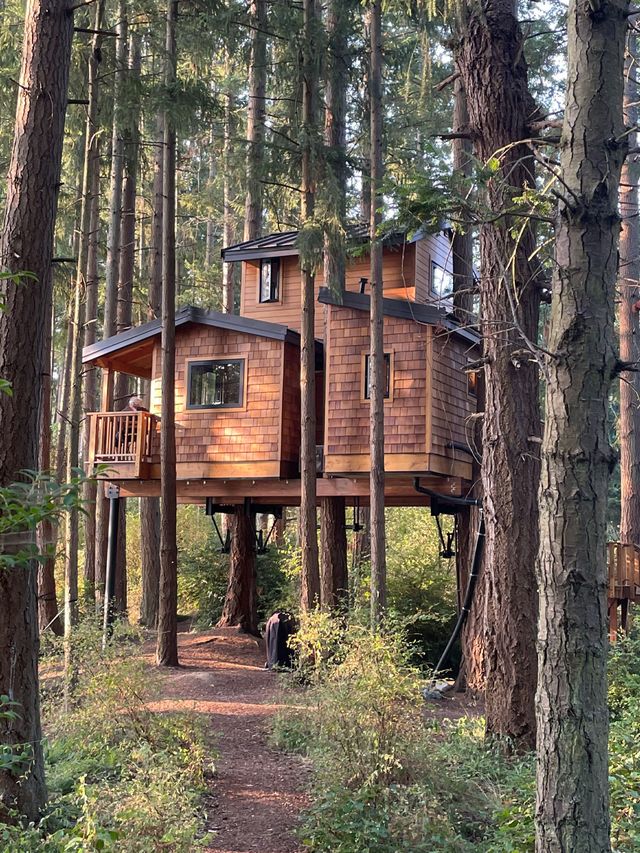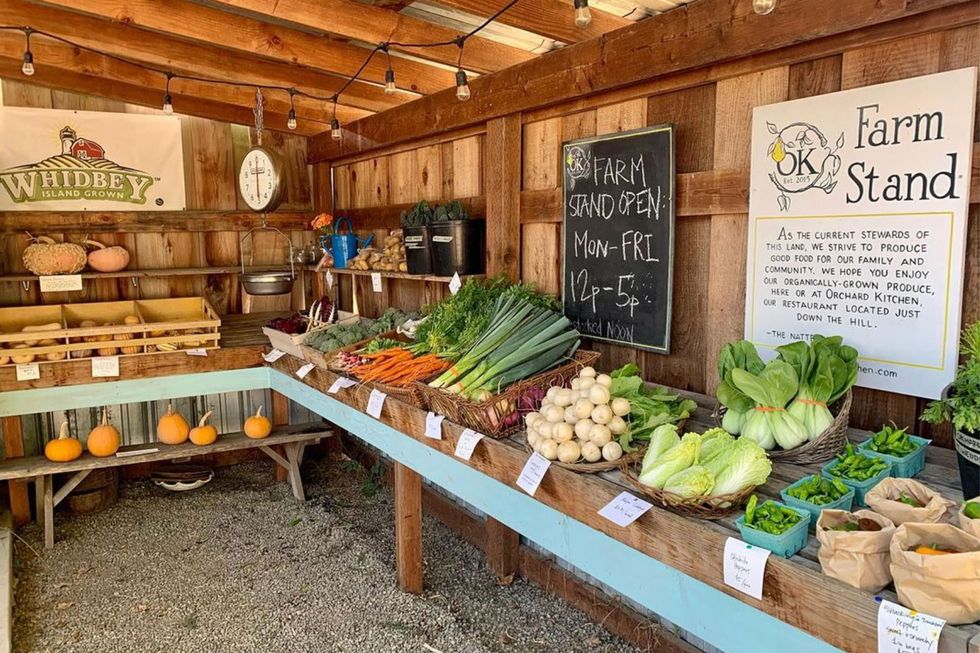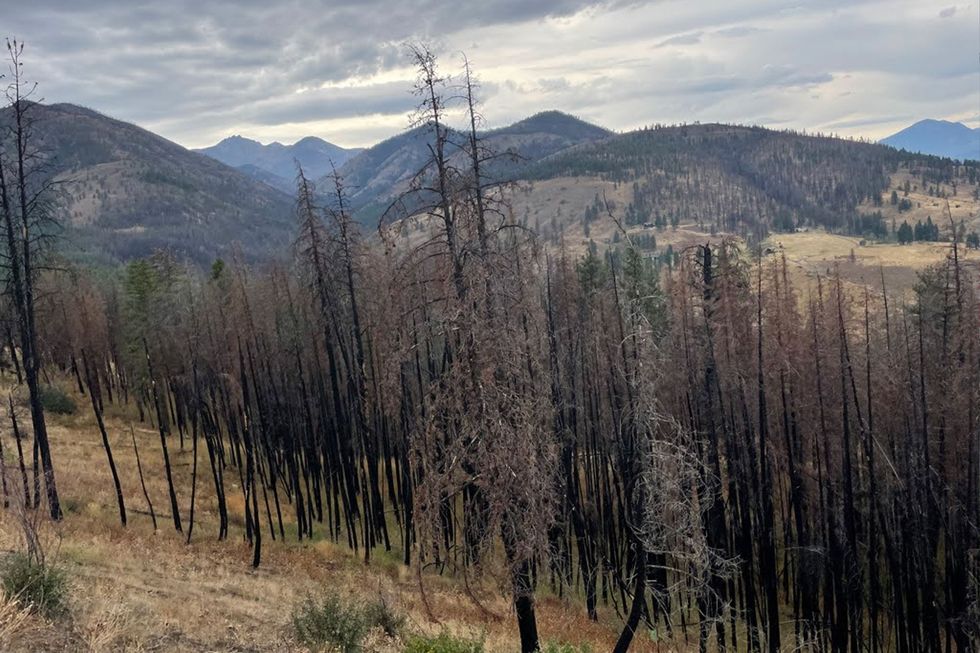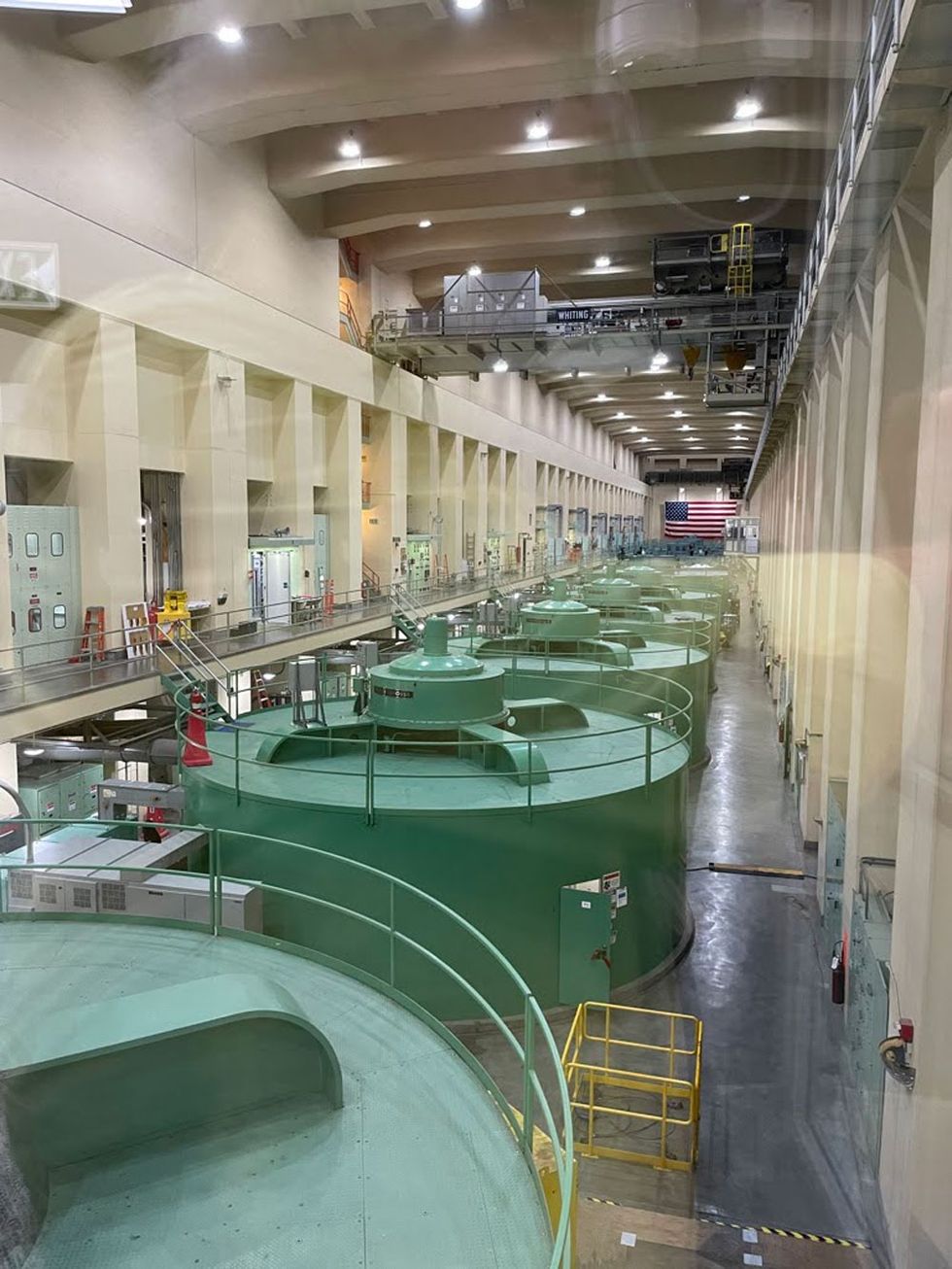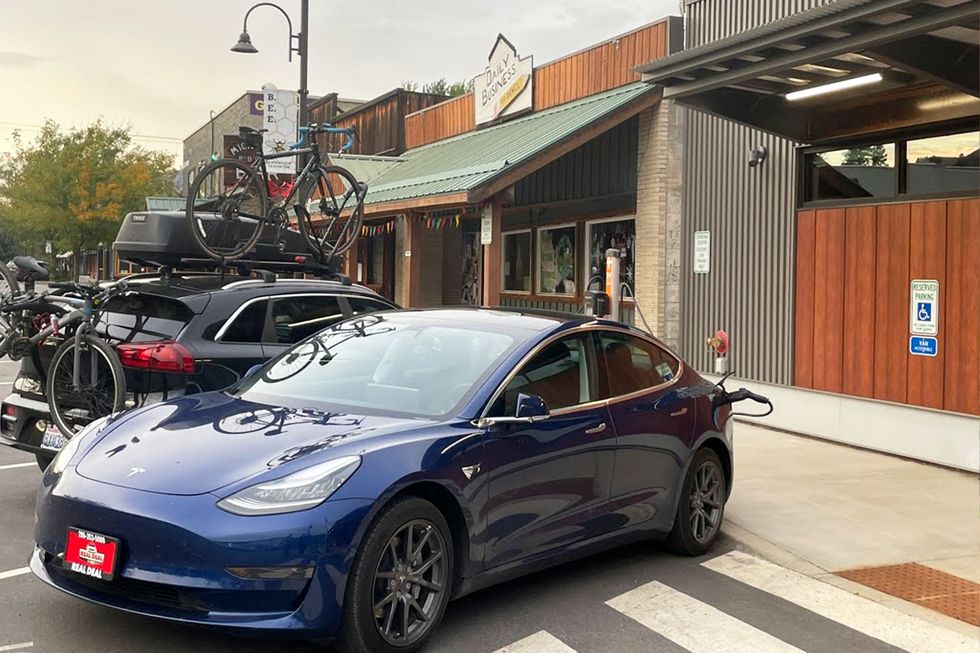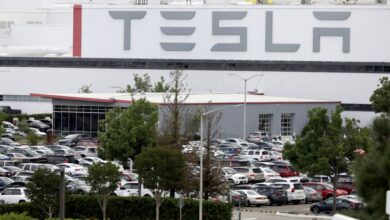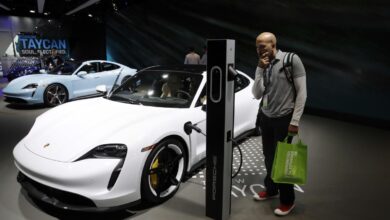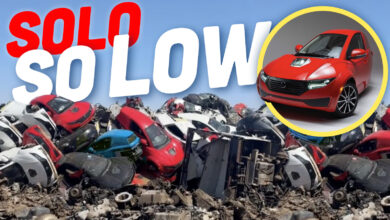Gas Takes a Holiday

My husband, Peter, and I recently decided to spend 10 days driving Washington State’s Cascade Loop. We went to experience the area’s dazzling scenery, sure, but also to try out an electric car.
We’ve been electric vehicle–curious for a while but uncertain about trading in our gas-powered 2005 Mini and finally plugging in. As a gal who loves driving a manual sports car too fast with the top down, I wasn’t sure that an EV would be as much of a thrill. Could we feel the freedom at the heart of the best road trips if we constantly had to worry about finding the next charger? We gave ourselves about a thousand miles to discover how an EV would perform in the wild.
One thing is certain: however rough the shift to EVs may be, they’ll be an inevitable part of our future—if we hope to have one. Living in California, it’s impossible to ignore the effects of climate change all around us: chalky orange skies caused by wildfires, apocalyptic flooding, and unseasonably hot days even during San Francisco’s blustery summers. Working with scientist Saul Griffith on his book Electrify, I learned that about 40 percent of all our carbon emissions comes from the machines in our homes, including our cars. According to the Environmental Protection Agency, every person who drives an EV instead of a gas-powered car saves an average of 4.6 tons of carbon a year from going into the atmosphere. Driving an EV also saves a lot of money on gas, especially where we were going, since Washington’s massive hydroelectric dams make its electricity some of the cheapest in the United States—around 13 cents per kilowatt-hour versus 18 cents per kilowatt-hour in the rest of the country.
All of that sounds great, but what if we ran out of juice in the boonies?
We rented a Tesla Model 3 sedan despite our reservations about the company’s CEO. We reserved one on the carshare app Turo from a car dealer who had bought a bunch of Teslas before the prices dropped and was trying to make up for his bad investment by renting them out. He didn’t spend much time explaining the car, and we had to remind him to throw in the adapter for 110-volt household outlets just in case we got stranded far from faster charging stations. Long story short: make sure you have the right adapters before you hit the road.
Peter, who is more patient in traffic than I usually am, drove the first leg. Adjusting the mirror and temperature controls on the Tesla’s touch screen, he noticed that the car was about three-quarters charged, with 194 miles to go. “This is the pokiest Tesla,” he griped.
As several reports note, Tesla batteries last 336 miles on a single charge. The high-end Model S gets 405 miles, but the standard Model 3 has the lowest range, supposedly 267 miles. Our car, with about 20,000 miles on it, got more like 220—about 100 miles less than a tank of gas in my Mini. Our first destination, on Whidbey Island—where we would start the Cascade Loop—was only 53 miles away, so we had plenty of juice. As we drove to the Mukilteo Ferry, I was impressed with the car’s smooth, quiet ride and powerful pickup—0 to 60 in three seconds, great for merging onto a crowded highway.
Then we had to wait 45 minutes in line to board the ferry, and I could see the car’s battery draining like an hourglass.
Once on Whidbey, surrounded by acres of lush green farmland, Douglas firs, red alders, and western red cedars, we started to feel like we were in a car commercial. We’d booked a tree house on the southern edge of the island, partly because it was all-electric (with an induction stove and heat pump) and partly because it sounded magical to sleep up in the trees.
When we arrived, the host brought out his collection of extension cords so we could charge the car overnight. On a household 110-volt charge, a Tesla Model 3 gets a trickle of about three miles per hour; with the charge we had left, it would take 24 hours to get to full. The tree house was 14 feet up in the air—a charming, compact cabin with a balcony supported by massive Douglas firs. But we didn’t want to spend our entire stay parked there. We hiked a trail abutting the property to Puget Sound. Down at the shore, it struck me that if sea levels rise as predicted, by the end of the century a tree house on the island won’t be so whimsical.
For Peter and me, a road trip isn’t just about scenery but is also a chance to explore the food grown in the places we’re visiting, the kinds of things we can’t experience anywhere else. I was eager to try Orchard Kitchen, run by chef Vincent Nattress and his wine-maven wife, Tyla. Nattress grew up on Whidbey and returned after stints cooking in France and Napa, including as executive chef at the then-two-Michelin-starred Meadowood.
I was expecting fancy but was delighted instead to drive up to a farm with a vegetable stand, acres of blooming flowers, a fruit orchard, and tidy rows of bolting greens bordering a red barn. We sat at a communal table outdoors and sipped shiso spritzers while Nattress explained a menu based in place, season, and soil. When I asked how this restaurant differed from the fine-dining restaurants he’d cooked in, he said, “Any ultrapremium restaurant is working with the same ingredients they can get FedExed from anywhere—foie gras, ahi tuna, caviar, Kobe beef—but here we limit ourselves to what grows here on this farm, in this region.”
“It forces creativity,” he said, looking around him. “It’s like writing poetry. You have a rhyme scheme with constraints.”
Our food arrived in waves of little bites, 12 in all, from beef carpaccio with crispy artichokes, basil aioli, greens, and Chioggia beets to grilled Washington albacore, ending with blackberry ice cream. Nothing was pretentious or fussy, just deeply satisfying tastes of the local landscape. In line with Nattress’s philosophy, we drove off feeling that climate-aware constraints—whether you’re eating food that doesn’t have to be trucked in with fossil fuels or driving a car that doesn’t foul the atmosphere—don’t have to amount to austerity. A clean-energy future doesn’t necessarily mean sacrifice; it can mean a 12-course tasting menu and a fast electric car.
That night, our tree house swayed in the warm, pine-scented breeze. All around us, giant firs pulled carbon from the atmosphere and locked it away with photosynthesis. Meanwhile, our Tesla was taking tiny tastes of electricity, but would they be enough to get us around the island the next day?
Whidbey Island is about 40 miles long (longer if you count the northern tip that curls back down the mainland), with a lot of territory to explore, and our car was only about half-charged overnight.
Since I’ve been driving a pretty analog Mini, the Tesla’s many features and touch screen interface forced me to catch up on a lot of tech. I was impressed by how zippy the car was, though I missed the feeling of control and power I get driving a stick. (EVs don’t have gears; a few brands, notably Lexus, have designed EVs with gearboxes that simulate shifting, but that’s just a silly gewgaw.) The Tesla was definitely fun to drive, though I wanted my convertible top, especially on such a glorious day.
We headed to Greenbank Farm, where we found a free Level 2, 240-volt charger (Tesla chargers are 480-volt) parked right next to an array of solar panels. The acre-big community solar project was installed in 2011 and now produces 180,000 kilowatt-hours of electricity annually—enough to power about 18 homes per year. We plugged in, and by the time we’d wandered around the farm and had a sandwich at the café, we’d added 50 miles to our “tank.”
For the rest of our day, we alternated little sips of electricity and wine. Regular charging may have limited our range, but it increased our serendipity, allowing us to discover new wineries and people along the way. We hooked up to a charger at Blooms Winery and sat on a sunny wooden patio chatting with a woman who, like many on the island, worked in tech in Seattle and, since the pandemic, had been doing so remotely from Whidbey. I had a long exchange about writing with our server, a young man who was waiting tables while he wrote a screenplay. But throughout these conversations, we never quite stopped thinking about the car, which was like a toddler, always needing to snack or nap, never just disappearing into the background.
That night, we drove to Coupeville, a misty town on the northern coast of the island with a touristy, old-timey Main Street. There, we dined at the Oystercatcher, another chef-driven, seasonal restaurant where the oysters tasted like they’d been dragged out of clean, cold water minutes before they were placed on our table. As we ate, the car charged up at the Coupeville Library, which used ChargePoint: $4.41 for 71 miles in just over two hours, the car finally full at 221 miles.
Our plan the next morning was to drive the dramatic North Cascades Highway (State Route 20) to our next destination, a lodge with a charger in the Methow Valley, 241 miles away. Given the distance, we stopped in Coupeville again to top up the battery while we ate breakfast. As we drove over Deception Pass, the skies became hazy. When we stopped at a fruit stand for blueberries, the in-car navigation (which mainly took us to Tesla chargers) suddenly wanted us to take a different, longer route. I checked the road conditions: S.R. 20 had just closed owing to wildfires. I swore.
“Climate change is so inconvenient,” said Peter, sardonically. “Time to be flexible.”
The wildfires were a stark reminder that our electric jaunt wasn’t just for fun but a test-drive of a new way of life. If more people lean into electricity over fossil fuels, we can reduce the sort of carbon emissions that were causing unpredictable weather and the wildfires from Canada to California. On this road trip, safely ensconced in our temperature-controlled Tesla, the wildfires were a brief inconvenience requiring a detour, but for residents and businesses, they were costly and potentially deadly.
We found an alternate route to our destination, via Stevens Pass, the lower part of the Cascade Loop. Going east on Highway 2, the scenery became more wooded, with cider mills and carved Bigfoot statues, winding up to the pass, an elevation of about 4,000 feet. With traffic diverted from S.R. 20 and construction on 2, we had a lot of long waits, ones where I had my first serious range panic wondering whether we should save electricity by turning off the audiobook we were listening to. I didn’t want to get stuck in that canyon and have to call AAA for a tow, since its roadside assistance didn’t provide juice to EVs in that area. We finally reached an array of Tesla Superchargers in Leavenworth, with just under 20 miles to spare, and high-fived each other in relief.
Leavenworth is an ersatz Bavarian village at the confluence of the Wenatchee River and Icicle Creek. The town of 2,500 sees about two million tourists a year, who come to drink beer, eat brats, and shop for nutcrackers and sweatpants that look like lederhosen. Peter and I drank beer, ate brats (when in Leavenworth…), and walked along the river for the hour it took to charge our car, costing $13 for the full “tank.” These enforced charging breaks gave us a chance to stop and experience surprising places we might otherwise have driven right by.
We drove north, passing a piece of the Columbia, a massive anaconda of a river that makes the Colorado look like a stream, to the Methow (“Mett-how”) Valley’s Sun Mountain Lodge, which we chose for its chargers. In our room at the hilltop hotel, the wide view of the craggy Cascades was obscured by smoke that filtered the sun into a brilliant orange, like that awful day nearly four years ago when Northern California looked like the surface of Mars.
“It’s like sitting in the smoking lounge at the airport,” Peter said, shutting the windows. Wind and rain battled to fuel or douse the wildfires the next day, scuttling our plans for swimming and paddling on nearby Patterson Lake. When the skies finally cleared, we took an electric-mountain-bike ride.
Though e-bikes are our main form of transportation in San Francisco (we use the Mini only on weekends or for rain), newly attuned to range anxiety, we kept checking our bike batteries as we climbed a mountain ravaged by previous wildfires but sprouting bright, green new life. The next morning, when the sun showed itself for the first time, I jumped into the rain-cooled lake and surfaced to admire the gleaming bark of the cottonwoods reflected in the water and the high-desert ponderosa pines climbing the hills of the North Cascades.
We headed back down toward Leavenworth, passing valleys filled with apple and plum trees, surrounded by scrubby hillsides and mountain canyons, the same territory described in the audiobook we were listening to, The Orchardist, by Amanda Coplin. On our way to Chelan, we had the eerie experience of listening to the protagonist in the book, an orchardist named Talmadge, describing his first train ride along the same route, marveling at the pace of modern life, “that his body could access both places in the realm of one day.” That difference of going from a mule to a train was how I felt going from a gas car to the electric one. “This was how people lived, now,” Talmadge thought, and I thought, This is how people have to live now, if we’re going to keep all this natural beauty around us.
We headed farther east the next day for Sun Lakes–Dry Falls State Park, beyond the Cascade Loop, passing vast wheat and hay fields to arrive at an unusual box-shaped canyon with massive basalt walls called a coulee.
The Dry Falls, at 3.5 miles wide, with a drop of 400 feet, dwarf Niagara, which is a mile wide, with a drop of 165 feet. At the end of the ice age about 18,000 years ago, global warming caused the ice dam at Lake Missoula to melt, unleashing a tremendous flood that blasted through eastern Washington at 65 miles an hour.
Geologists in the 19th century believed that the unique cliffs and strange “channeled scablands” in this area were the result of slow glaciation. However, a renegade geologist named J. Harlen Bretz meticulously measured and observed the area on foot in the 1920s and concluded that only a catastrophic flood could have caused the bizarre landscape.
“The magnitude of the erosive changes wrought by these glacial streams is nothing short of amazing,” Bretz wrote in 1923. Scientists at the time were wary of any whiff of catastrophe because it supported religious ideas that God had created the world in a few cataclysmic days. (John Soennichsen, an author who lives in the region, told Bretz’s story in an epic adventure book, Bretz’s Flood, a book I read before our road trip.)
Reviled and rebutted by his peers, Bretz was redeemed at age 96 when he was finally proven right and awarded the Penrose Medal, the Geological Society of America’s highest honor. (“All my enemies are dead, so I have no one to gloat over,” he told his son.) Bretz’s contemporaries were so stuck on their theory of gradual change that they couldn’t accept the stark evidence of catastrophic, albeit natural, climate change. I wondered whether the notion that geological change must be gradual is part of what keeps some of us in denial to this day despite compelling evidence that climate change is happening—and happening rapidly.
At Sun Lakes–Dry Falls State Park, we went for a scorching hike around a monolith and a refreshing swim in a pristine lake. I wondered whether the RV gas hogs I’d been seeing, which get an average of 10 miles per gallon, depending on weight (a 40-gallon tank would mean $200 every 400 miles!), could be entirely electrified. It turns out that Winnebago, among others, is already working on an electric RV, which comes with its own solar panels to help power it along.
Our battery was now at 75 percent, and I was nervous about driving ever farther from charging stations. We were hoping for an EV charger at our next stop, Soap Lake Natural Spa and Resort, but the guy who answered the phone there growled, “I’m not keen on electric cars.” It seemed I’d inadvertently lobbed a mini culture-war grenade by mentioning our EV.
I told him I was a guest who wasn’t keen on getting stranded, and he grudgingly told me about a nearby park with a charger. We arrived in time for some good pizza while the car slurped up some much-needed juice, and then I took a swim in Soap Lake, which is so full of minerals you can float atop it like in the Dead Sea. The resort owners, whatever their politics, had powered the place with heat pumps and electricity, not propane, likely because of the cheaper cost. When framed as a cost-saving measure, electrification becomes less like some green California dream and more like a viable way to keep the lights on.
Peter checked the charger and chatted with a sportsman with a pickup truck and a gun rack. The man initially sneered at our EV, but when Peter told him that not only was the electric version of his Ford pickup, the F-150 Lightning, way cheaper to drive but its battery could also power his house for an entire week during a disaster, he suddenly became interested.
At dinner in a local café, a server with “FREE” tattooed on his knuckles said that many people think EVs allow the government to spy on us. I turned back to my cocktail and didn’t ask whether those freedom lovers use cell phones. When the guy elaborated that the locals like to get along without the government because they believe in “kingdoms,” since they all originally came from Europe, I also did not say that my ancestors, too, came from Europe, but they left to escape the tyranny of monarchies.
That evening, alone on the banks of Soap Lake, Peter played guitar while I went mud walking in the moonlight.
So far on our trip, we’d charged the car for free or very little money. When we drove north up a stunning coulee with sheer cliffs and wide lakes to the Grand Coulee Dam, we understood why. At the time it was built—it was finished in 1941—it was the largest dam in the world and the largest single source of electricity. The dam generates 21 billion kilowatt-hours of electricity per year, enough to power about two million households all over the western states for a year.
When the dam was built, writes Marc Reisner in Cadillac Desert, “the high dam spelled doom for most of the salmon in the Columbia River.” But he also notes that, given that the United States needed massive amounts of electricity at the time to produce the aluminum to build the warplanes to fight the Nazis, “it probably won the Second World War.”
Still, with all that electricity, there was no charger at the visitors’ center.
On day nine, the wildfires were finally calmed by rain, and the northern part of the Cascade Loop, S.R. 20, was open. We headed back to the Methow Valley, to an inn in Mazama, a little town full of humans so fit from rock climbing, cycling, and hiking that they seemed like a more highly evolved species.
The inn had a free charger, which was a good thing because the Tesla was nearly empty when we arrived, but we had to wait for a Ford F-150 Lightning that was using it. It takes that truck about 10 hours to charge on a Level 2 (240-volt) charger, which just goes to show that even in the post–fossil fuel era, there are still resource-guzzling beasts among us. We went for a hike (though not for 10 hours), and when we returned, someone else’s Tesla was hooked up to the charger, where it charged overnight. We had to make do with electricity dribbled from an outdoor 110-volt plug. When the same piggy Tesla was still plugged in the next afternoon, we grumbled and left a note on the windshield.
Desperate for juice, we checked our app and found a charger in the nearby town of Twisp. While we charged up for free at town hall, we ate across the street at Tappi, a delightful find with a wood-fired oven and a passionate Italian chef at the paddle.
Back in Mazama, we finished charging at the inn overnight. Mindful of the bad charger etiquette we’d witnessed the day before, I moved the car as soon as I woke up.
That morning, we were finally able to drive S.R. 20 through North Cascades National Park. It was cloudy, but the peaks were massive, with sheer rock walls and waterfall streams cutting through. Though lower than the Rockies I grew up with in Colorado, these hills were somehow more impressive for looming closer.
The highway cut through the middle of the enormous national park, and the charred remains of wildfire were everywhere. Because of the recent fires, we weren’t allowed out of the car, except to take a little hike by a stream at the visitors’ center. It felt a little like being on a safari, where we could engage with the natural world only through the window of a car.
It took a couple of hours to exit the park, then its rural surroundings, and get back to the crowded suburban highways we hadn’t seen in 10 days. We returned the car to its owner, who offered to take us to the airport, since he was going that way. His gas-powered Mazda felt like a slow mule compared with the EV we’d been driving.
As he drove us, I did some back-of-the-envelope math: by the end of our road trip, Peter and I had driven 1,200 miles and had spent $27.62 on charging. Had we driven a car with an internal combustion engine, given an average 25.4 miles per gallon at the $5 per gallon we’d seen at gas stations we’d passed, we would’ve spent about $236 on gas—enough for another dinner with wine at Orchard Kitchen.
Ours had been a trip into a possible future with an electric vehicle. It hadn’t always been perfect, given the low-level nagging of anxiety and the judgment of some fossil fuel–committed locals, but it was viable and will only grow more so as charging stations proliferate and battery life improves.
Will we swap our current car for an EV? Not right away: the new electric Mini convertible gets only 150 miles of range. But by the time our Mini dies, next-generation batteries should be powerful enough to take us on a road trip. Maybe we’ll even be able to fly to Seattle on an electrified plane. One thing is certain: as the bumper sticker on my Mini says, my next car will be electric.•
Laura Fraser is the author of four books of nonfiction, including the bestselling memoir . She writes the newsletter The Phrazer.
